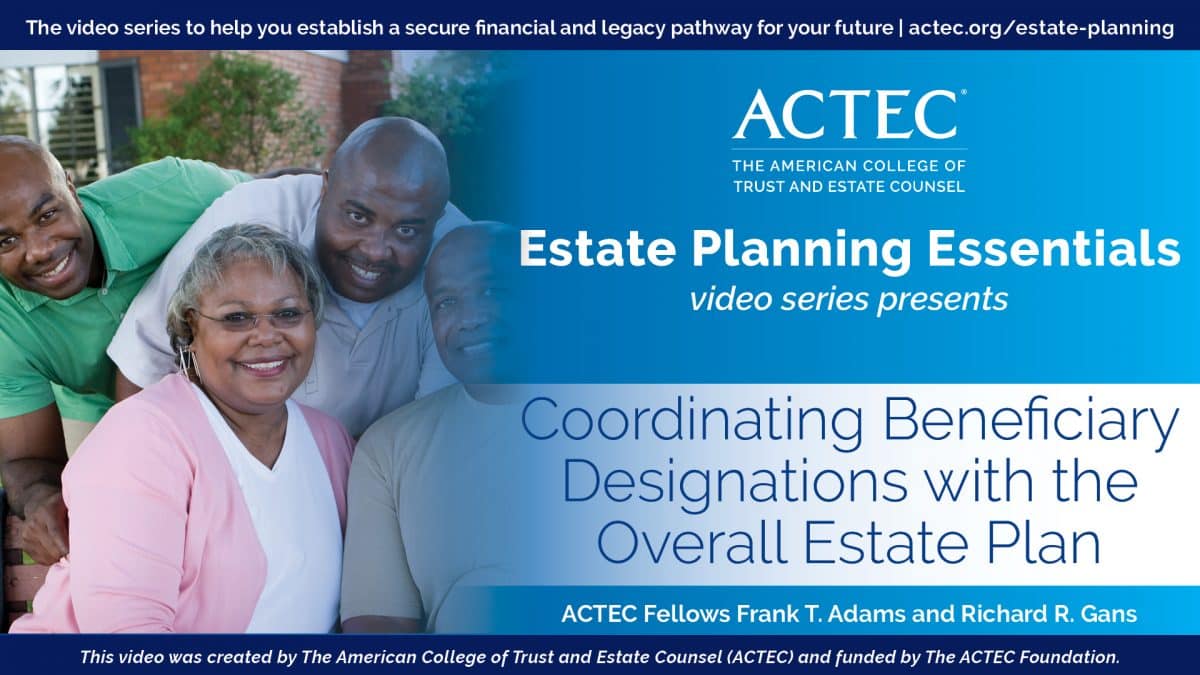Today, people change jobs frequently and need to move or roll over their IRA with each job change. Reviewing and understanding IRA beneficiary designations throughout your life is critical so you can adjust for changes in your family as you age.
ACTEC Fellows Richard R. Gans and Alfred J. Stashis, Jr. explain typical IRA beneficiary scenarios and why it’s critical to review EVERY time you set up or rollover your IRA to avoid probate.
Resources
Transcript
Greetings from sunny Florida. My name is Rick Gans. I’m an ACTEC Fellow from Sarasota, Florida, and I’m joined today by Al Stashis, who is an ACTEC Fellow from Naples, Florida, and our topic today is Common IRA Beneficiary Designation Scenarios. And so, Al, what happens if you don’t have a beneficiary designation?
Al Stashis: Hi Rick. Well, it’s great to be with you. Yeah. If you die with your IRA account and no beneficiary designated, what happens is the plan documents will determine who the default beneficiary is. So, typically, it’s the decedent’s estate or the surviving spouse.
And if it’s the estate, the thing that you have to worry about is, well, that may mean you need to open a probate which you otherwise would not have needed to commence, and the other issue to be concerned about there is, by having the IRA pass through the probate estate, it may become subject to claims of the decedent’s creditors which you could have otherwise have avoided if you had it payable directly to individuals.
Rick Gans: So, if you’ve named a beneficiary at your old provider, and you move the IRA to a new provider, do you have to name a new beneficiary?
Al Stashis: No. That’s a common misconception that clients have. The simple answer is, basically, whenever you move your IRA from Provider A to Provider B, you need to sign a new beneficiary designation.
Rick Gans: So, Al, you hear a lot that the surviving spouse is the best IRA beneficiary. Why is that the case?
Al Stashis: Sure. I think the reason is the spouse has the most number of options in terms of what they can do to receive the IRA. But by far what we have as the most popular option that spouses will take is to roll over the IRA into their own retirement account, and that gives them maximum flexibility in terms of administering the IRA, it gives them maximum deferral, in terms of taking required distributions. Generally, when they roll it over, they don’t have to take any distributions until they reach age 72.
And the other thing the spouse can do when they roll it over into their own IRA is to name their own beneficiaries. So, that gives – like I said, they have total control over the account, get to determine deferral distributions, and name their own beneficiaries.
Rick Gans: Okay. You’ve convinced me and made a good case that deferral is a good option for a surviving spouse, but what happens if the surviving spouse needs the money and doesn’t want to defer, particularly if that spouse is young?
Al Stashis: Yeah. So, if the spouse is under age 59-and-a-half, they’re probably not going to want to roll it over into their own IRA account because, if they do that and they take the money out before 59-and-a-half, they’re going to have a 10% early withdrawal penalty in addition to the ordinary income tax.
So, with a younger-spouse scenario you want to generally have the younger spouse take the IRA as an inherited IRA, and that will mean they have to, eventually, start to take distributions immediately, based on their life expectancy, but based on your hypothetical, that’s okay, they’re going to need the money anyway. So, the fact that they have to take distributions immediately and can’t defer, is not so much a problem.
Rick Gans: So, no penalty on those types of distributions, right?
Al Stashis: That’s right. No penalty when you take it as inherited IRA.
Rick Gans: Okay. So, then an inherited IRA is different than a roll over. So, can a child do a roll over IRA, or do they have to get stuck with an inherited IRA?
Al Stashis: Now, the children are stuck with the inherited IRA. So, generally the children…or the account’s going to be divided. So, you have four children, the account would be divided up four ways for the four children if that’s who’s named on the beneficiary designation form, and each child can take out their share all at once if they want to do that. They probably would not want to do that because, if they do that, they’re going to be subject to taxation at one time – taxed all in one year.
So, the more common scenario for the children, the adult children, in this case, would be to open an inherited IRA and have their portion of the decedent’s IRA added to the child’s inherited IRA, and if this child is an adult, not a minor, not disabled or chronically ill, then they’re going to have 10 years over which that account has to be paid out. So, that 10-year distribution rule allows them to spread out their taxable income over that 10-year period.
Rick Gans: Okay. So, what happens if one of the children is a minor?
Al Stashis: If there’s a minor child, and the minor child is named directly on the beneficiary designation form, then sometimes what you can do is open a UTMA account, a Uniform Transfers to Minor Act account. And basically, when that happens, you have some other adult who is named the custodian to manage those funds for the benefit of that minor until they reach a certain age, 18 or 21, or 25. And then, at that point, the child takes over administration of whatever remains in the account.
If the UTMA option is not available, then what may have to happen is you might have to have a guardianship proceeding or conservatorship proceeding in your particular state, and that is where a court appoints a guardian or conservator to administer that account for the benefit of that minor until they reach the age of majority. It’s typically 18 in most states. And then, at that point, at age 18, the minor becomes an adult and gets to take over the administration of whatever remains in that account.
So, the knock on the guardianship, of course, is, it’s a court-supervised proceeding, it’s got lawyer involvement, and so forth. So, we try to avoid guardianship where we can, and the UTMA option is good option in many cases. If for whatever reason that won’t work for you, you might think about naming a trust to receive the IRA benefits for the minor child…and that can avoid the court proceeding.
Rick Gans: Gotcha. Wow. So, what I’m hearing is that there’s all kinds of things that can go right, and there’s all kinds of things that can go wrong here, and it’s a pretty complicated area, and a lot rides on getting some good advice and giving some goods thoughts to preparing the IRA beneficiary designation form.
I tell my clients, you can…no do-overs with IRAs. You got to get it right the first time. Is that…pretty much resonate with what you tell your folks?
Al Stashis: Yes, yes. I think that’s exactly right. There’s a lot at stake with respect to retirement accounts, and just everybody has one. So, this is something that everyone should be looking at and thinking about. And you should review your beneficiary designations from time to time. You want to make sure that they’re consistent with your overall estate plan and you want to make sure that you understand how they work.
So, if you haven’t reviewed them recently and you want to review your retirement accounts and your beneficiary designations, it’s a good time to contact your estate planning attorney to take a look at those.
Rick Gans: Well, that’s great advice. Thank you for being here and spending some time with us today. We appreciate your expertise and be well.
Al Stashis: Thanks a lot, Rick. I enjoyed it.
Featured Video
Coordinating Beneficiary Designations with the Overall Estate Plan
Assets such as insurance, annuities, pensions, 401ks and IRAs have a beneficiary designation. Experts explain considerations when coordinating an estate plan.
ACTEC Estate Planning Essentials

ACTEC Fellows provide answers to frequently asked trust and estate planning questions in this video series.



